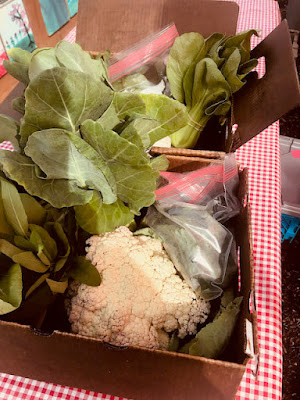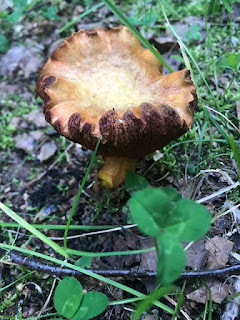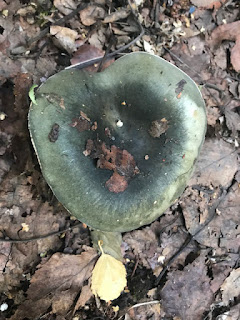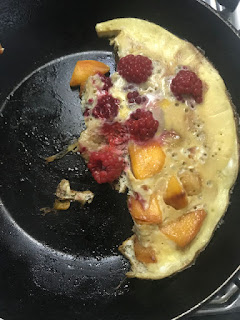So much . . .
Weekly trips to pick up our CSA (Community Supported Agriculture) [It's a USDA website so go quick before the regime either takes it down because it's too 'woke' or it crashes from neglect or incompetence.]
They use salt - some Alaska salt - and mix it with things for use in cooking, eating, and making your house smell better, like in the simmer pots.
I've highlighted soap artist (seriously, what she does is art!) Kit
before. She showed me a prototype of a soap she's working on that will have a Rorschach test on it. I asked if there are psychiatrist interpretations included. Those, she assured me, would cost a lot more. Learn more at
MirthAlaska.com.

There was a long line at the WIC table. This market is in the lowest income area of Anchorage and the
Grow North Farm here - sponsored by RAIS (Refugee Assistance and Immigration Service), a part of Catholic Social Services - is an urban farm worked by refugees.
It was gray and threatening, but not raining all that day, but it finally came down on the ride home. It was so light it really only got my clothes slightly damp. And my odometer with drops.
I've gone past my 1600 km goal for the summer - one reason I guess I haven't blogged as much. All that biking along Anchorage's green bike paths has been good for my physical and mental health during this disastrous time in US history.
The picture below was on an earlier ride on the Campbell Creek south trail. And I'm delaying today's ride to get this post up.
Again, a somewhat random picture here. Walking down the steps after a routine doctor visit at Providence, I was greeted with the lovely sounds of live piano music. The acoustics in the huge atrium entrance are great and the notes pulled me over to listen to the end and thank the musician.

Our power, phone/internet went out during the windstorm a week ago Friday. This downed cottonwood was the culprit. Chugach Electric had the power back on the next morning when we woke up. Alaska Communications took until Tuesday or Wednesday to come out and then they didn't have the equipment to fix it right, so while the phone line and internet are back on, the wire is lying on the ground and about two feet off the ground in some places I have to walk. In what world is that acceptable? Alaska Communications is so terrible! The techs I have to call now and then and those who come out to the house are generally very good. It's just the management that has promised me fiber every summer since 2023 and not delivered that pisses me off. And the website that has the circle of death spinning hopelessly when I try to pay online, and then they charge me a %25 late fee because I couldn't pay online. With no grace period. None. Visa emails me three days before to remind me to pay my bill. ACS emails three days after it's due to say, "We screwed you again." I'm ready to cut that cord forever.
Got that off my chest.
Our neighbor did hook us up to his power with a series of extension cords to power the refrigerator since we didn't know how long it was going to take to get the power back. We decided to go to
Queen of Sheba for dinner that night. Here's David, the owner and chef, chatting with us after our meal.
Ethiopian food is truly special and delicious. Anchorage folks, go eat there and keep them in business. The prices are reasonable for this day and age.
It's between Northern Lights and Benson - on Dawson.
So, probably this should have been three or four blog post spread over the week.
But I'm not done. I've been reading several books at once, but I'll just highlight
Caraval. This was a recommendation from my 12 year old granddaughter. When I told her I was number 25 on the waiting list at Loussac Library, she said, "I told you that you'll never get it."
But I got an email saying it was mine to pick up. I understand why people read it. Each chapter ends with a cliffhanger of sorts. And I think the author has
synesthesia, because every feeling is associated with a color, some vibrating. Lots more descriptions of odors than you normally see too. And I don't think Nancy Drew ever had chills from the touch of a young man's bare chest leaning against her.
I'd say this teen fiction is the gateway drug to adult romance fiction.
Moving along - I'm still overwhelmed with the barrage of outrageous statements and actions spewing from the White House. Here are a few images that I've saved as I try to find new ways to ask my junior US Senator how long he thinks he can wade in this filth before he is sucked under completely. He gleefully points at what he sees as 'wins' for Alaska, while the president tramples the constitution by kidnapping people off the streets, invading US cities with our military, ignoring judge's orders, bombing boaters in international waters, gerrymandering Texas to squeeze out Democratic house seats, and on and on and on. I didn't even mention Epstein. And Dan Sullivan turns a blind eye to all of that in exchange for some oil drilling permits.
My previous post was on the normalization of the word normalization. Nothing could illustrate that point better than this post by His Travesty.
What previous president could have done something like this and not been impeached? Some say it's just 'a humorous bit' but I did a paper on government humor once. What I learned was that government humor that is self deprecating is fine, but government humor that punches down is NOT fine.
And then his Vice Travesty defends another military operation off the coast of Venezuela:

Has anyone seen any evidence that these are cartel members (just like we haven't seen any evidence that Kilmar Abrego Garcia was a member of Tren de Aragua gang)?
I copied this one for Labor Day. We're back to the time when business owners could call on the government to bring in troops to break up labor unions. And when I say 'break up' I mean that literally. But they stood in solidarity until they won their rights which have benefited most of us. (You know, 40 day weeks, paid overtime, health benefits, the right to grieve bad treatment, etc.) We have to be as brave and persistent now to prevent what's happening today.

I don't believe ignorance is greater now than it was. But the propaganda forces of the fascists have powerfully taken advantage of that ignorance, and the latent fears of white America. They've taken all the damage to the working classes done by exporting jobs and increasing the income gap and blamed it on Black people and immigrants.
I remember when the first polio vaccines became available and we got poked at school. My small pox vaccine scar no longer really shows, but I was inoculated.
Public health programs have saved more lives than medical treatment of individuals. As I look for good
links to explain the importance of public health to society, I see that some of the most important public health initiatives - clean water and sewage systems - are so taken for granted that they aren't even mentioned. But we haven't always had clean water and sewage systems. And parts of the world still don't have them.
President Nixon famously had an enemies list. But no president has ever, so blatantly used the powers of the federal government to go after his perceived enemies. The president is publicly telling the Department of Justice to investigate and prosecute people who oppose him. And as a blogger, I found this cartoon a bit close to home.
I tell myself I'm just a tiny voice out in the wilderness and they have much bigger targets than me. But I also notice that Google says my recent posts have way more hits that I usually get. Stat Counter has always shown far fewer hits than Google, but they also track individual visitors. I can't tell if I really have more hits or whether there are more bots. In times past when there were lots more hits, it looked like someone scraping my blog for content, and more recently for AI. But when that happens you can see a single user going to thirty or more different pages per day. So many hits on a single page is different.
In any case, I want people to stay strong and be engaged in fighting this regime to preserve our democracy (not to mention our health and economy and general well being.) Do what you can. And take breaks to laugh, enjoy nature, good friends. Find like minded people. And know your rights.
And a teaser for a post I hope to put up this week.
 There was a long line at the WIC table. This market is in the lowest income area of Anchorage and the Grow North Farm here - sponsored by RAIS (Refugee Assistance and Immigration Service), a part of Catholic Social Services - is an urban farm worked by refugees.
There was a long line at the WIC table. This market is in the lowest income area of Anchorage and the Grow North Farm here - sponsored by RAIS (Refugee Assistance and Immigration Service), a part of Catholic Social Services - is an urban farm worked by refugees. 





























.jpeg)





















